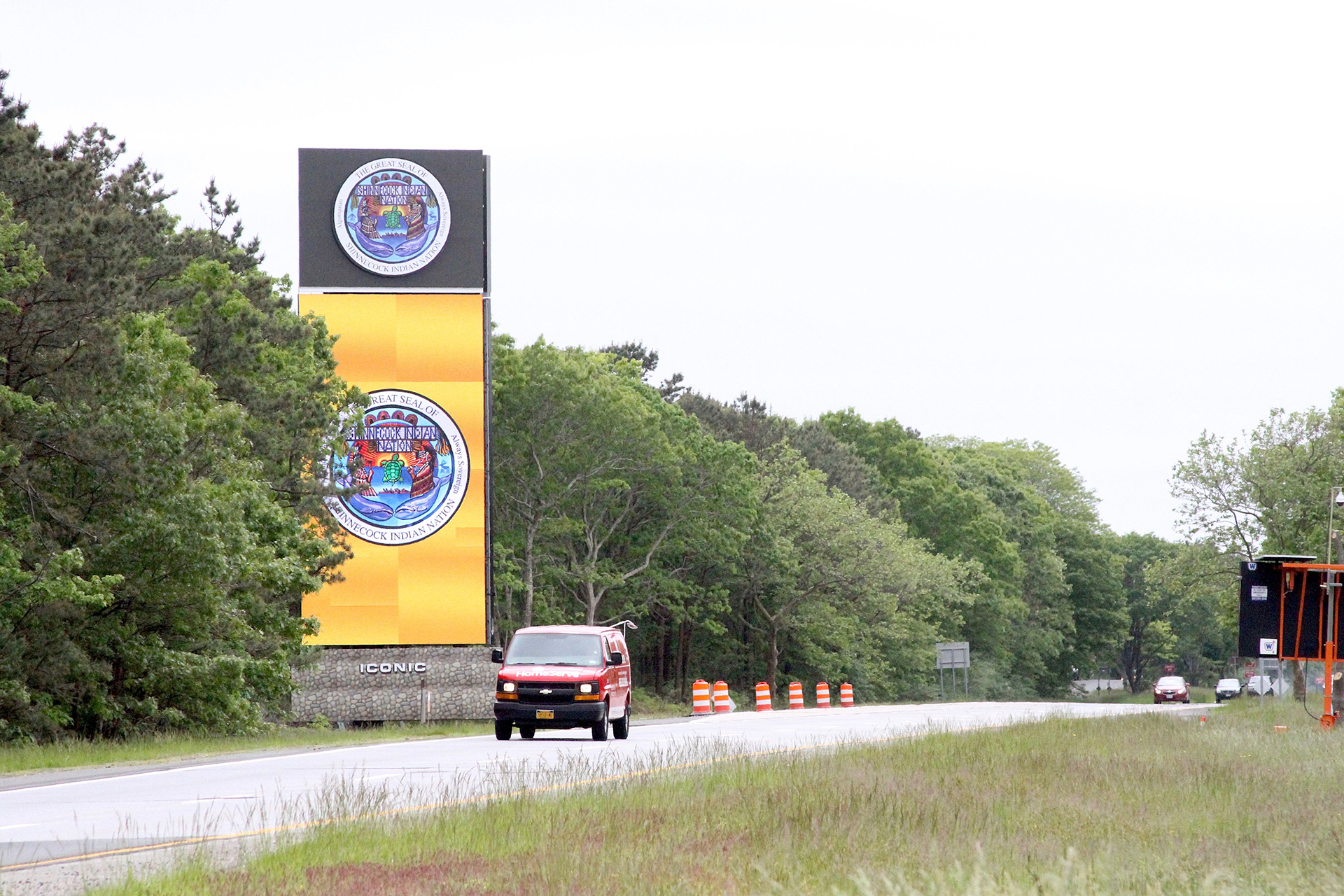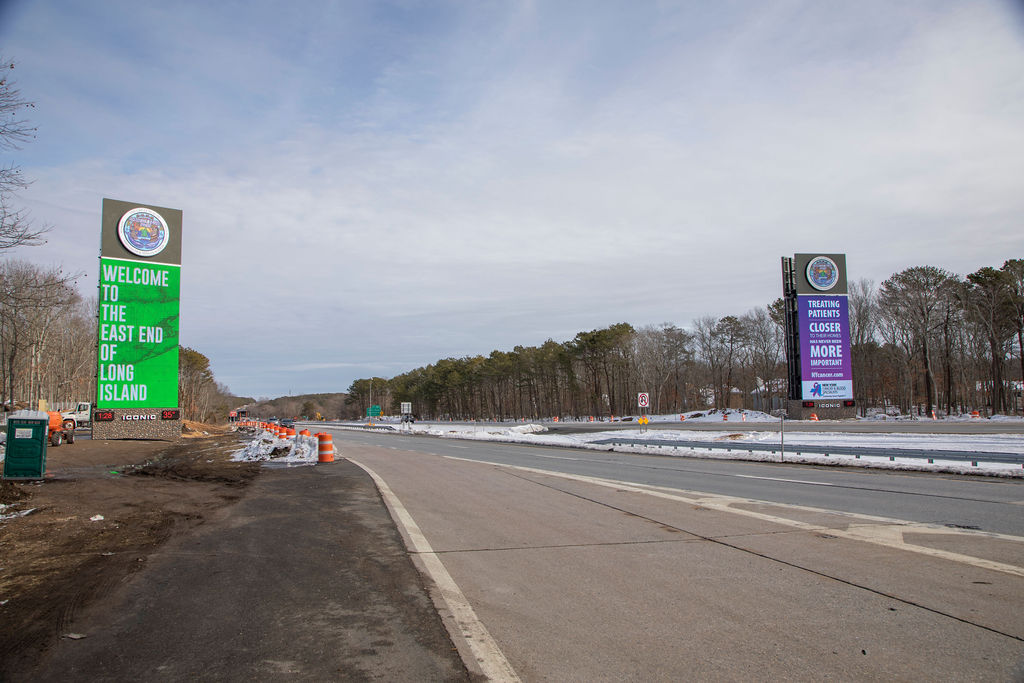Shinnecock Monuments Appeal Has Crucial Implications for Tribe’s Economic Future

In late-March a New York State appeals court heard oral arguments in a case that will determine the fate of a five-year-old lawsuit the state filed against the Shinnecock Nation. While the suit specifically challenges the construction and operation of “the Monuments,” a pair of controversial 61-foot electronic billboards on either side of Sunrise Highway in Hampton Bays, the State Supreme Court Appellate Division’s decision will have far-reaching implications for the Nation’s long-term economic development plans.
The Shinnecock have already begun construction of a gas station/travel plaza on Sunrise Highway near the Monuments billboards. Also in the planning stages are a spa/resort on the Peconic Bay and other development projects, all of which would help fund various tribal assistance programs and provide a much needed boost to the Nation’s finances.
The Monuments lawsuit is particularly relevant to the tribe’s gas station/travel plaza project. In order for the travel plaza to be viable as a business, motorists must be able to access it from Sunrise Highway. While the Shinnecock control the land on which the plaza is being built, the New York State Department of Transportation (DOT) controls the necessary access points to and from the plaza on Sunrise Highway.
In essence, the tribe owns the house, but the state owns the driveway.
According to former Tribal Chairman Bryan Polite, New York State representatives have tied access to the travel plaza directly to the resolution of the Monuments case.
“The DOT is saying that they’re not going to talk to us until this, in my opinion, frivolous lawsuit against us is resolved,” Polite said at a Southampton Town Board Meeting in February.
While a decision on the Monuments case could be delivered anytime between now and June, when the court’s current session ends, the ruling could be appealed to the New York State Court of Appeals, the highest court in the state.
The Shinnecock Nation is keenly aware that a case that is still unresolved after five years could very easily drag on for far longer pending appeals – and the tribe knows that it would be economically disastrous for its travel plaza project to remain in limbo during that time.
Though Polite stepped down from his leadership position in March, he retained his seat on the Nation’s General Council. One of the last significant acts of the Council under Polite’s chairmanship was an eyebrow-raising attempt to pressure the Southampton community and its elected representatives into lobbying New York State on the Nation’s behalf.

In February the tribe unexpectedly cut an access road through a wooded area on part of its sovereign territory (known locally as Westwoods) from the travel plaza site to Newtown Road in Hampton Bays. Some local residents – particularly those whose backyard property lines sit very close to the new road – registered their concerns about the project.
Amid community pushback, Polite strongly implied that the ultimate form the access road will take – whether or not it will become a paved thoroughfare – is contingent on whether the Nation can convince the state to grant the tribe the access it needs to and from its travel plaza on Sunrise Highway.
“It would be very helpful for this current board, as well as community members who might be agitated by a road coming off of Newtown Road, to really help us to pressure – or to demand, actually – that New York State go through the regular process and work with us on an off-ramp,” Polite said at the February Town Council meeting.
The original lawsuit was filed in 2019. It alleged that the Nation violated state law by erecting billboards without Department of Transportation permits. In an effort to circumvent sovereign immunity issues, the state sued seven members of the Shinnecock Tribal Council individually (including then-Chairman Polite), rather than suing the tribe itself. Also named as a defendant in the suit was the construction firm hired by the Shinnecock to perform the work.
After the suit was filed, a judge issued a stop-work order, but the Nation disregarded it and the shovels kept digging, an act that served to ratchet up the temperature of the case a few degrees.
The state requested and won a temporary restraining order, but in June 2019 the Nation filed a motion to dismiss the case on the grounds that it had been granted sovereign immunity by the federal government. The tribe argued that the case could only be allowed to proceed if Congress specifically waived its sovereign immunity right — an action few, if any, believed Congress would take.
The following year, the Nation won a key legal battle, but fell short of winning the war. New York State filed a preliminary injunction to force the Shinnecock to remove the Monuments. State Supreme Court Justice Sanford Neil Berland denied the state’s request and strongly implied that the state’s case hadn’t met a crucial evidentiary threshold. However, Justice Berland declined to dismiss the case entirely.
Five years down the road, a decision will finally be handed down – and it could come within a matter of weeks.
While it’s difficult to gauge exactly how the justices might be leaning based on the oral arguments, the primary points of contention centered around the implicit rights granted by the Shinnecock’s status as a federally recognized sovereign tribe. More specifically, the question seemed to be: Where does immunity from prosecution begin and end based on that sovereign status?
The Shinnecock argued that their sovereign immunity allowed them to ignore a dually executed stop-work order issued by a New York State Supreme Court Justice. The justices didn’t appear entirely convinced by that argument. On the other hand, the justices appeared at least somewhat more sympathetic to the defense’s contention that it was illegal to sue Tribal Council members individually rather than file suit against the Shinnecock Nation as an entity.
Another topic that spurred a fair amount of pointed questioning from the justices was the fact that the property near the Monuments had been granted a state easement (a legal right that allows a person or entity to use or access another person or entity’s property for a specific purpose.) The state argued that the presence of the easement in and of itself grants the state certain legal rights and imbues it with certain responsibilities (to guard against distracted driving, for example).
While it seems extremely unlikely that the Shinnecock will be compelled by the court to remove their electronic billboards, the fate of the tribe’s travel plaza and other future economic development projects are less clear. The court’s decision in the Monuments case – the possibility of an appeal notwithstanding – should provide some much needed clarity.



